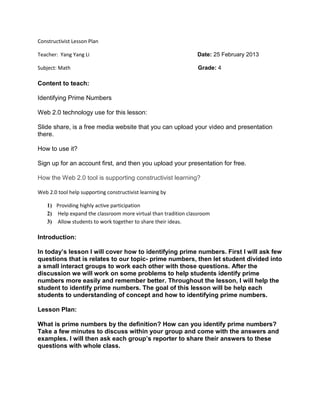Report
Share

Recommended
Recommended
More Related Content
What's hot
What's hot (20)
Activate Your Learners! Active Learning Strategies for Fostering Participant ...

Activate Your Learners! Active Learning Strategies for Fostering Participant ...
Student Centered Year Plan Using The Backwards Approach

Student Centered Year Plan Using The Backwards Approach
Similar to Constructivist lesson plan
Similar to Constructivist lesson plan (20)
Teacher hand out problem solving bouira march 2018

Teacher hand out problem solving bouira march 2018
Problem solving in teaching english djelfa march 29 meeting 2017

Problem solving in teaching english djelfa march 29 meeting 2017
Cognitive and meta cognitive strategies for problem solving in Mathematics

Cognitive and meta cognitive strategies for problem solving in Mathematics
Collaborative Activities,HOTS Activities,Creative Learning.pdf

Collaborative Activities,HOTS Activities,Creative Learning.pdf
Constructivist lesson plan
- 1. Constructivist Lesson Plan Teacher: Yang Yang Li Date: 25 February 2013 Subject: Math Grade: 4 Content to teach: Identifying Prime Numbers Web 2.0 technology use for this lesson: Slide share, is a free media website that you can upload your video and presentation there. How to use it? Sign up for an account first, and then you upload your presentation for free. How the Web 2.0 tool is supporting constructivist learning? Web 2.0 tool help supporting constructivist learning by 1) Providing highly active participation 2) Help expand the classroom more virtual than tradition classroom 3) Allow students to work together to share their ideas. Introduction: In today’s lesson I will cover how to identifying prime numbers. First I will ask few questions that is relates to our topic- prime numbers, then let student divided into a small interact groups to work each other with those questions. After the discussion we will work on some problems to help students identify prime numbers more easily and remember better. Throughout the lesson, I will help the student to identify prime numbers. The goal of this lesson will be help each students to understanding of concept and how to identifying prime numbers. Lesson Plan: What is prime numbers by the definition? How can you identify prime numbers? Take a few minutes to discuss within your group and come with the answers and examples. I will then ask each group’s reporter to share their answers to these questions with whole class.
- 2. What is prime numbers by the definition? A prime number is a natural number that is greater than 1, no positive divisions other than 1 and itself. How can you identify prime numbers? We can identify prime numbers in many ways: 1) the number can only divide 1 and itself.2) using the prime factorization tree. Objectives: -objective 1: define, identify, and recognize a prime number -objective 2: class discussion -objective 3: working on problems Investigate: There are many ways that we can help to categorize numbers. What types of numbers do we know? (In general, students may list odd/even, positive/negative, counting numbers, fractions, integers, or whole numbers . . . ) . Explanation: Explain the concept of prime numbers and composite numbers without using the grouping explanation. Have students re-explain prime and composite numbers using the grouping terminology.
- 3. Conclusion: We have seen that numbers have patterns. You may notice the prime numbers is exist as big numbers and small numbers. The smallest prime number is two. The largest prime number is at infinity. Grouping is the key to help determine if a number is prime or not. These groupings are also known as factors.